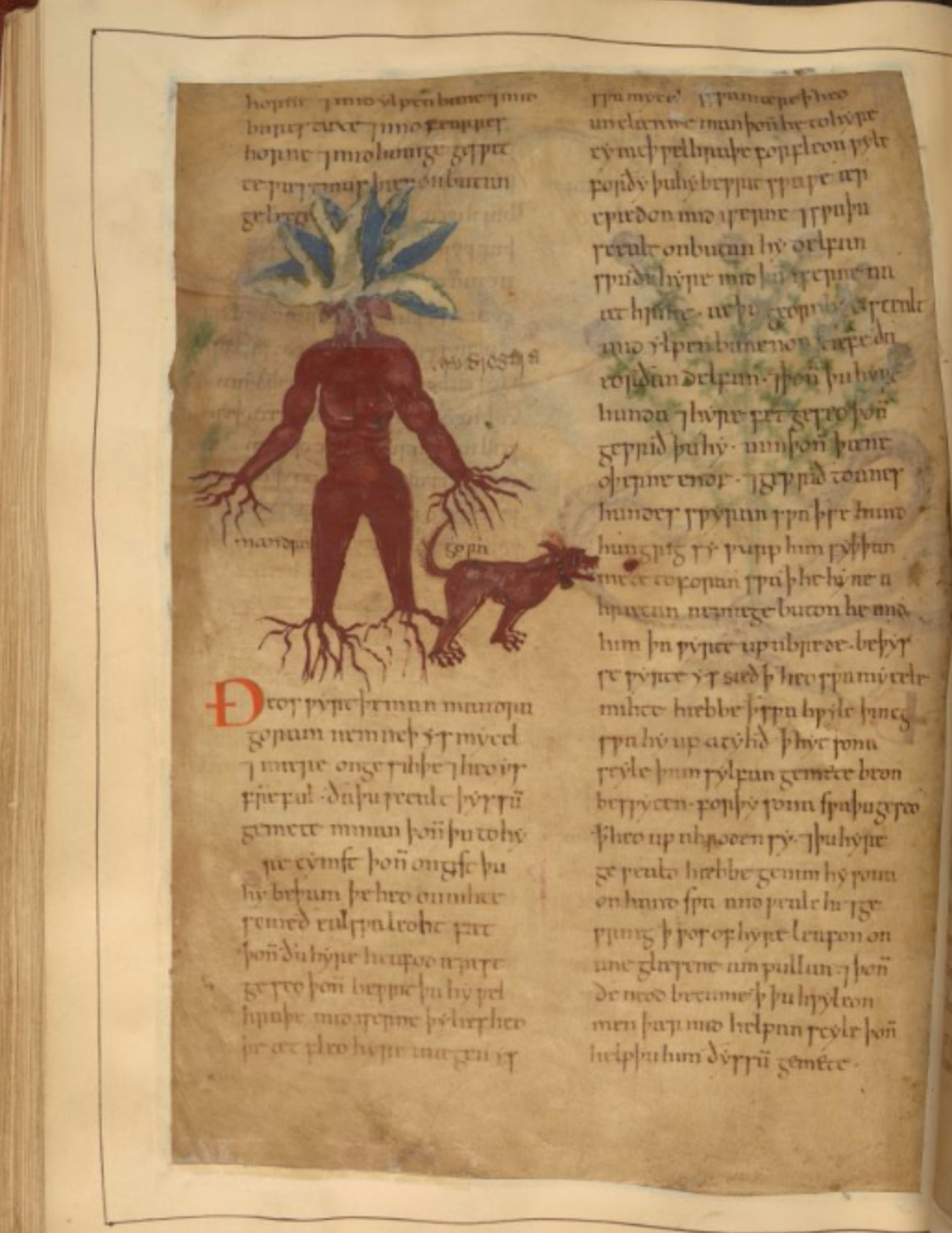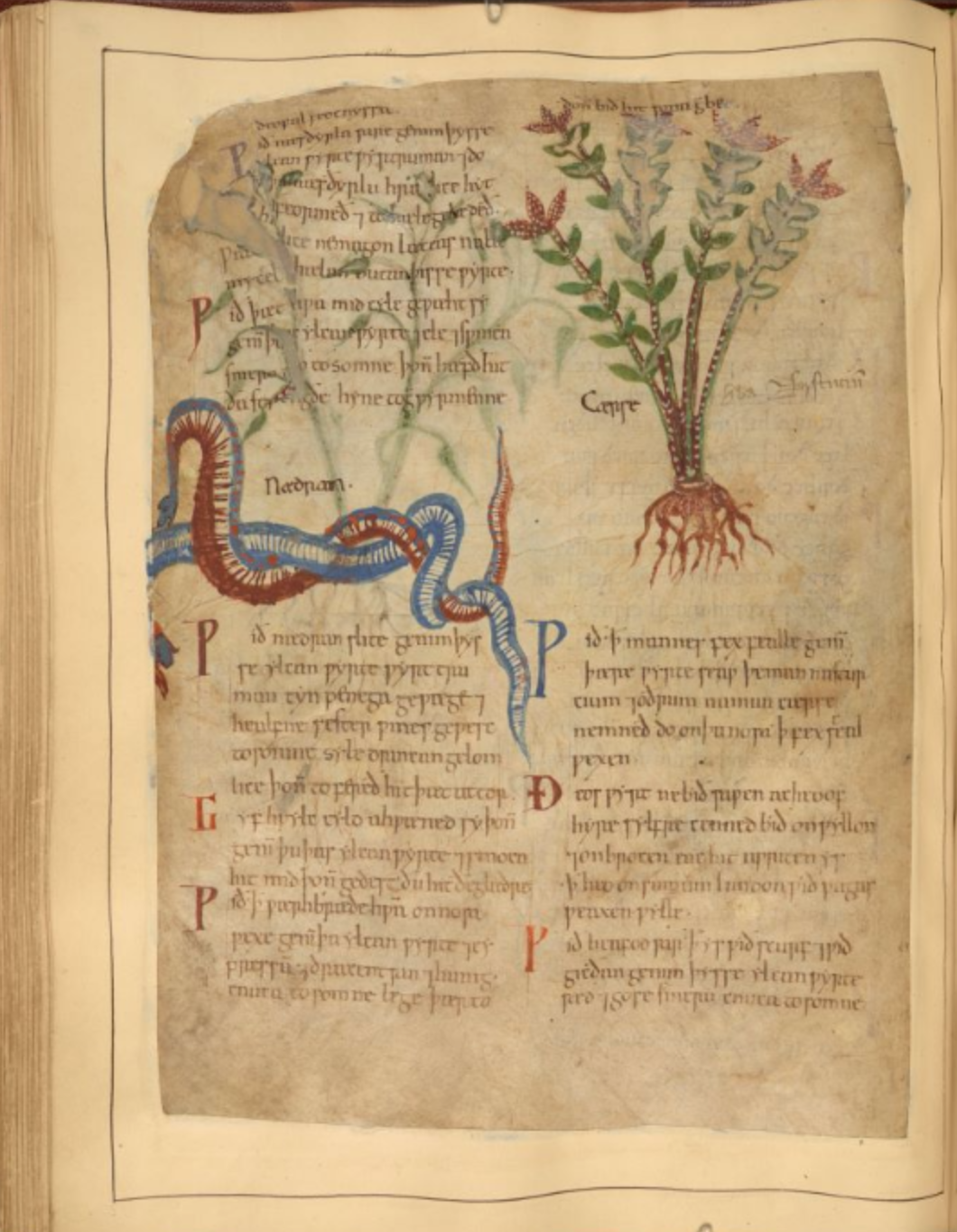
If you don’t much care for modern medicine, entire industries have arisen to provide you with more “alternative” or “natural” varieties of remedies, mostly involving the consumption of plants. Publishers have put out guides to their use by the dozens. In a way, those books have a place in a long tradition, stretching back to a time well before modern medicine existed as something to be an alternative to. Just recently, the British Library digitized the oldest such volume, a thousand-year-old illuminated manuscript known as the Cotton MS Vitellius C III. The book, writes the British Library’s Alison Hudson, “is the only surviving illustrated Old English herbal, or book describing plants and their uses.” (The sole condition note: “leaves damaged by fire in 1731.”)

The manuscript’s Old English is actually the translation of “a text which used to be attributed to a 4th-century writer known as Pseudo-Apuleius, now recognized as several different Late Antique authors whose texts were subsequently combined.” It also includes “translations of Late Antique texts on the medicinal properties of badgers” and another text “on medicines derived from parts of four-legged animals.”
(Somehow one doesn’t imagine those latter sections playing quite as well with today’s alternative-medicine market.) Each entry about a plant or animal features “its name in various languages; descriptions of ailments it can be used to treat; and instructions for finding and preparing it.”

Quite a few of the species with which the guide deals would have been directly known to few or no Anglo-Saxons in those days, and some of the entries, such as the one describing dragonswort as ideally “grown in dragon’s blood,” seem more fanciful than others. As with many a Medieval work, the book freely mixes fact and lore: to pick the mandrake root (pictured at the top of the post), “said to shine at night and to flee from impure persons,” the guide recommends “an iron tool (to dig around it), an ivory staff (to dig the plant itself up), a dog (to help you pull it out), and quick reflexes.” You can behold these and other pages of the Cotton MS Vitellius C III in zoomable high resolution at the British Library’s online manuscript viewer. While the remedies themselves might never have been particularly effective, their accompanying illustrations do remain strange and amusing even a millennium later — and isn’t laughter supposed to be the best medicine?

Related Content:
1,000-Year-Old Manuscript of Beowulf Digitized and Now Online
The Art of Swimming, 1587: A Manual with Woodcut Illustrations
The Turin Erotic Papyrus: The Oldest Known Depiction of Human Sexuality (Circa 1150 B.C.E.)
Based in Seoul, Colin Marshall writes and broadcasts on cities and culture. He’s at work on the book The Stateless City: a Walk through 21st-Century Los Angeles, the video series The City in Cinema, the crowdfunded journalism project Where Is the City of the Future?, and the Los Angeles Review of Books’ Korea Blog. Follow him on Twitter at @colinmarshall or on Facebook.


Hello, I would love a download of the old herbal online
Unfortunate the tone at the latter, as if the history and use of medicine prior to the 20th century is laughable…it is not.
Plantenboek
They recently tried one of those ancient remedies on modern patients and 85% of them got well.
We will decimate the forests and jungles nor even quicker. Better when it was known to only those who respect the natural bond of earth and its creatures — us included- healing each other.
THANK YOU FOR THE HERBAL TREASURE!
THANK YOU FOR THE BOOK
I would absolutely love a copy please. Have relied in the past on grandma’s knowledge or other I have gathered over the years this would be a real go to treasure.
Hi I would like a copy the old herbal book please
Thank you
Would also love a copy please
I would love a copy.
I would absolutely love a copy please.
would like the book lam a traditional healer
I am a botanist and Horticulturist and part of a physic garden group so Iw would love a copy.
How do i obtain a copy
Can I have a copy of the ancient medicinal please.
I would love to have a copy of this manuscript as well please.
I am very interested in receiving a copy. Looking forward to this read.
How do we get a copy? I am all for naturalremediesvs big corrupt pharmaceutical. PromiseI respect this knowledgeand hold it sacred.
I would like a copy too.
Very interested in this. How can we get this in print?
Thank you.
Very informative.
I would love to get a copy.
What a wonderful find. I would absolutely love to receive a copy.
Beautifull, van i receive a copy too please, thank you so much.
I would greatly appreciate a copy. Is there also a modern English translation? If not, no worries, my husband can mostly ready Olde English. Thank you.
Would like ebook or digital copy
Is there a readable translated version of this manuscript. I am unable to decipher the script and language.
Would love an English translated version please!
Desearía una copia,les quedaré eternamente agradecidos.
Good question/Have an answer?
send me a copy please
I don’t think so…
anyone have a copy of this book… if anyone have..please
ME ENCANTARÍA TENER UNA COPIA DE ESTE LIBRO. iNTERESANTÍSIMO. MUCHAS GRACIAS
I would love a copy, please and thank you! I am spiritual and a naturalist and want to become a biodynamic herb farmer.
Hello, please send me a copy of that ancient herbal book
Hello, please send me a copy of that ancient herbal book.
could i please have copy of the ancient herbal book, thank you
hello im very interested in getting a copy as i use old remedies i got off my mum when ever i am sick and i refuse too go too doc unless they dont work. it would be wonderful too read and see what they used back then.
regards
jackie
I would love a copy of the Ancient Herbal book. Thanks!
I would love a copy of the “Ancient Herbal Book”.
Yup. Totally agree.
How do I download a copy of this?
I would love a copy of the Ancient Herbal book. Thanks!
Hi how do I download a copy of the Ancient Herbal book. Thanks Steve
I would love a copy of this please.
Please send me a copy of the book
Yes Im in dire need of a copy please.
I would like a copy of the book. Thank you
Pleasant Day to ALL
Hope this short message finds you all well.
I am into herbal healing. I own a Herbal store.
I would love love love a copy of this manuscript.…. 1,000-Year-Old Illustrated Guide to the Medicinal Use of Plants.….especially as we are now in dire times vs the pharma.
I would be forever grateful if you all would share it with me.
Thanks in advance
Warm Regards
I would LOVE a copy of this please! Thank you! Fascinating! MT
Hello how can I obtain a copy. Thank you
Very interesting.…I would definitely be interested in receiving a copy of this book. I like learning about different herbs and their uses especially those from the past!
Thank you in advance.
Very interesting.…I would definitely be interested in receiving a copy of this book. I like learning about different herbs and their uses especially those from the past!
I like learning about different herbs and their uses especially those from the past!
Hello
I would like a copy. How do I go about getting one? Thanks
just like every one els I would like to get my hands on the book thanks for letting me take A peek at it
I have been searching for a decade for this book. Who would have thought that all I had to do was Google it?? I know, right? Well I believe God has lead me this day to find this post and your transcript and download. I would love to have a copy of this masterpiece. Although not in print it will be cherished as a digital piece of History and I can always have it printed if I want to. Thank you and God Bless you!
Hello,
I would like a pdf copy of the book please.
Is there any way to get a copy of this book?
PDF or email.
Hello. can you give a copy of that old the old book please,thank you
Hello I’m in need of the copy old traditional healing book or pdf
Good Morning
May I please get a copy of this book.
Thanks you
Adrian
May l please receive this important herbal information for herbal health.
I would love a digital copy of this precious knowledge please.
Thank you,
A Morby
Please send me copy, and if you wish i can send you one other book.
I would love a copy. Thank you.
Like everyone else i would be grateful 🙏 for a copy.. God bless you for the find and for the sharing..
This sounds really interesting, i am into healing, herbs, and really want to help more people, and with knowledge i can do this, i would love a copy of the book please.
Thank you
Love this please send me a copy as every one else …!
I would love a copy of this book. Thank You and god bless .
Thank you for this. May i get the download ?
How do I get a downloaded copy? Thank you!
Hello, I would love a download of the old herbal online
Hi, May I purchase or download a copy of your book please? Thank you!
I hope this ling finds you well. This is facinating information. I am a fine art horticultural painter, and gardener. And I would love a cope of this amazing treatise too!!
thank you KML
I hope this ling finds you well. This is fasinating information. I am a fine art horticultural painter, and gardener. And I would love a cope of this amazing treatise too!!
thank you KML
I hope this ling finds you well. This is fasinating information. I am a fine art horticultural painter, and gardener. And I would love a cope of this amazing treatise too!!
thank you
Hello, can I have a copy of book please? Thank you so much ☀️
Hi,
how can I get hold of a copy of th ancient book (or ebook) of medicinal plants. I heard about this years ago…
Much appreciated, Jyoti